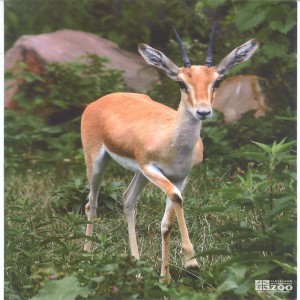Slender Horned Gazelle
[Gazella leptoceros leptoceros]

The slender-horned gazelle is a medium-sized gazelle, with the average adult height about 30 inches, and weight 60 pounds. These are the palest in coloration of all gazelles. General coloration is an extremely pale sandy-fawn, with a faint brownish band along the lower flank. A median band on the blaze and cheeks is a darker sandy color, with a facial white stripe from above the eye to the muzzle. The horns are approximately 16 inches in length, almost straight in both males and females, and strongly ringed. They curve slightly backwards, sometimes diverging widely. The female's horns are less curved. The hooves are slightly enlarged for walking on soft sand. The ears are very large.
Slender-horned gazelles are classed as endangered because of excessive hunting by people, for sale of meat and their horns, and also because of competition from domestic animals.
Location: Animals Formerly at Zoo
Share:
Range
The range of the slender horned gazelle is Africa: central Algeria to Egypt.
Habitat
The slender horned gazelle inhabits desert and open bushland, from sea level to 19,000 feet.
Conservation Status
EndangeredPrimary Threats
Human Wildlife Coexistence, Climate ChangeGestation
156-169 days
Litter
1
Behavior
Slender-horned gazelles are generally found in groups of 10 to 30 females and their young. Males are found either in small groups or as solitary individuals. Lone adult males establish territories and have temporary control over females that enter their territories. Herbivorous grazers or browsers, they obtain most of their water from the plants they consume. They are strongly nomadic, their broad hooves enabling them to traverse deep sand dunes.
Reproduction
Reproduction in slender horned gazelles is seasonal. Males establish territories in August and September, mating with groups of females that move through. The gestation period is 156 to 169 days. Births are in January or February, with normally a single offspring. Sexual maturity is attained in the second breeding season.
Wild Diet
Herbivorous: grazer or browser (leaves & berries of desert plants)
